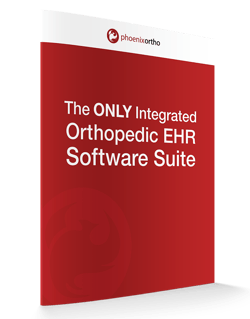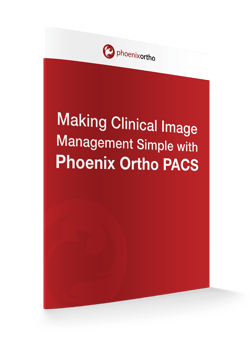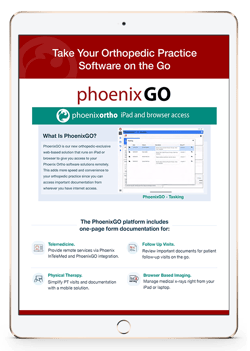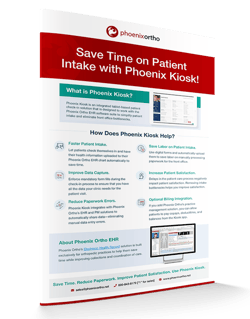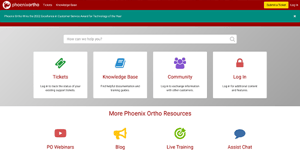In any orthopedic practice, a common goal is to see and help as many patients as possible—or, in other words, to improve patient flow. Being able to increase patient intake allows a clinic to earn more money and do more good for the community at large.
For this reason, it is important for practices to find ways to reduce clinic workflow bottlenecks and improve patient flow.
To help you optimize your patient flow and eliminate bottlenecks in your clinic, we’ll discuss what a bottleneck is for clinics, how they affect your patient flow, and some strategies for eliminating bottlenecks as well as improving patient flow management in general.
What Is a Bottleneck?
A bottleneck is any point in a process where progress may be slowed or halted—creating delays and reducing productivity. For a clinic workflow, bottlenecks represent inefficiencies in a process that keep patients from being processed quickly and efficiently.
What Is Patient Flow?
Patient flow is a term for how patients are moved through the clinic. The flow rate for a patient is affected by how they are processed at each step of their visit from initial intake, to waiting, their visit with the physician, payment, and discharge.
The Problem with Bottlenecks That Affect Patient Flow
In orthopedic clinics, the delays from bottlenecks in clinical workflows can create issues such as:
- A reduction in the number of patients that can be processed each day;
- Reduced income as fewer patients are processed;
- Lower patient satisfaction; and
- Loss of repeat business as patients seek out more efficient care facilities with lower wait times.
If the delays caused by clinic workflow bottlenecks are severe enough, they can put a practice’s continued solvency at risk.
Some things that orthopedic practitioners can do to reduce bottlenecks in their clinic workflows include:
1. Running a Bottleneck Analysis On Their Workflows
Before a clinic can fix a bottleneck in one of their workflows, they first need to know the cause of the bottleneck. A bottleneck analysis helps a business study its workflows from start to finish to identify issues that contribute to creating the impediment.
Such an analysis might call for creating a map of the workflow with a detailed list of steps and branching paths that the process might take. This map should include all steps of the process, both before and after the bottleneck, so as to account for all factors that may be contributing to the issue.
Each step listed in the workflow map should then highlight all of the inputs needed and the average time each step should take. This helps practitioners be a bit more granular regarding the cause of a bottleneck in their patient intake and care.
For example, during a bottleneck analysis, it may be revealed that one particular process consistently takes three times as long as it should. Just based on the extra time involved, it is obvious that the process step needs refinement. It may be necessary to analyze the process in detail to see what’s causing the delay and see if there’s a way to fix the issue causing the delay.
With access to information about process inputs, it is often easier to establish the cause of a delay in a process step—such as taking longer to fill out or retrieve patient paperwork so a particular process can begin.
By learning about the root causes of delays through a workflow bottleneck analysis, clinics can make targeted changes to their processes. Hopefully, this can improve patient wait times without sacrificing quality of care.
2. Increasing Process Efficiency to Eliminate Bottlenecks in the Clinic Workflow
A common answer to the question “how to improve patient flow in clinics?” is to try to find ways to make clinical processes more efficient. For example, if the task of retrieving patient data so a treatment can begin is taking too long, a clinic might turn to Electronic Health Records (EHR) software to help automate the process and save time.
Another way to increase clinic workflow efficiency is to streamline a process, where possible, to reduce complexity. By minimizing process complexity, a clinic can make the process easier to complete—improving consistency while saving time. EHR systems can help to streamline documentation processes significantly while improving the consistency of paperwork. The improvements to paperwork consistency can, in turn, reduce issues with payouts later on.
3. Increasing Staff On Hand to Conduct a Specific Process
In some instances, a clinic may try to add more staff to address a bottleneck effect in business that is caused by a specific process. The basic idea is that by adding more people, the workload capacity for the clinic will also increase—at least, for the particular processes the additional staff members are qualified for.
However, this is not always a scalable and sustainable solution for improving patient wait times. It is very easy to overstaff based on temporary conditions, only for patient visits to drop off significantly once the busy season is over. This leaves a practice with too many people for their level of business, constricting cash flow.
4. Ensuring That Patients Are Doctor-Ready Before Entering the Exam Room
A major source of delays in many medical practices is the issue of rushing patients into examination rooms before they are ready to see a doctor. Just because a patient is in an exam room does not mean that they are finished waiting—nor does it mean that they are not part of a patient flow bottleneck.
If a patient is put into an examination room to see a caregiver, but still needs to wait for paperwork to be filed before the examination can begin, that patient’s care is still being delayed as surely as if they were still sitting in the waiting room.
Preparing patients so that they are ready to be treated or examined before moving them out of the waiting room is crucial to providing patient-focused care that prevents unexpected delays.
5. Considering the Overbooking of Appointments
In any medical practice, patient no-shows are a constant concern. Practices set aside a certain amount of time to see patients and provide care—time that they may not be fully reimbursed for if the patient fails to show up. “No-show” fees can serve as a deterrent but are rarely enough to ensure that every patient shows up for their scheduled appointment.
To counter this issue, many clinical practices engage in overbooking, scheduling extra patient visits that go above and beyond the actual capacity of the clinic to account for their no-shows. Studies into the practice of overbooking, such as one from the Mental Health Center of Denver, note that “Even with highly variable service times, many clinics will achieve positive net results with overbooking.”
The issue is that when a clinic is vastly overbooked, it can lead to significant delays in patient care—even to the point that scheduled patients that do show up on time may not be able to be seen by a physician before the clinic’s closing hours.
To prevent delays in patient care from the overbooking of patient visits, it is important for an orthopaedic practice to carefully analyze their no-show rate and take that into account when scheduling patient visits. Also, sending out automated reminders to patients the day before and day of care can help to keep patients from forgetting about their appointments—thus reducing the no-show rate.
How to Improve Patient Flow without Sacrificing Quality of Care
The above tips are all ways for a clinic to identify and remove bottlenecks in their key processes. But, how can orthopedic practices improve patient flow (and the patient experience) to increase satisfaction with the clinic’s services?
Here are a few ideas:
Create a Patient Flow Team to Analyze Clinic Workflows.
While running a bottleneck analysis is important, who is responsible for that analysis in the first place? Assembling a team of people to analyze workflows to identify opportunities for improvement is a foundational step for getting ideas on how to improve workflows.
If building a team of people to analyze and improve workflows isn’t practical, consider setting up a suggestion box for ways to improve patient flows. Front office staff, assistants, and other doctors in the practice may have some good ideas for streamlining patient intake and processing.
Go Digital with Patient Charts and Data.
Physically copying and handing out patient information within the clinic takes time and is prone to data entry error—especially if someone in the clinic has bad handwriting.
Switching to using primarily digital means of sharing information saves time on processing paperwork and minimizes the risk of manual data entry errors. As soon as data is put into the patient file, everyone in the clinic on the system can pull it up without having to manually copy anything.
Consider Adjusting Staffing Levels.
If the bottleneck delaying patient flow is caused by a lack of labor for a critical process, it may be necessary to add more staff to that process. It’s typically less costly to add another employee to the practice than it is to pay an experienced worker overtime to cover the labor shortage.
Add a Patient Intake Solution.
To simplify patient intake workflows, consider using a patient intake solution (like Phoenix Kiosk). Patient intake software lets patients enter their data digitally so it appears immediately in their patient chart. Additionally, these solutions should accept payment information to streamline payment processes.
Adopt Remote Visit Technology.
In recent years, the use of telehealth/telemedicine software to deliver care has really increased. One of the key advantages of remote health solutions is that patients don’t have to travel to the clinic and wait for a physician’s attention—instead, they can make a report in a phone app and get a response as they go about their day.
Part of the reason for the adoption of telehealth was to limit exposure risks of the COVID-19 pandemic. However, the convenience factor will continue to drive adoption and make the technology a must-have for modern practices.
If there are severe patient flow problems in the practice, it can also help to consult a patient flow coordinator or a business manager to get more in-depth advice. These specialists may have important insights into how to streamline or optimize operations to improve patient flow and experience in the practice.
Of course, improving flow rate for a patient is still just one aspect of providing high-quality care and increasing patient satisfaction. There are other factors, such as the interpersonal skills of clinic staff, perception of care quality, and convenience factors that also contribute to patient satisfaction and likelihood of repeat visits.
How EHR Systems Help to Eliminate Clinic Workflow Bottlenecks
When improving patient wait times by removing process bottlenecks is a major goal for a clinic, Electronic Health Records systems can be almost indispensable. EHR systems can help eliminate bottlenecks in many patient care processes by:
- Streamlining Charting Processes. Phoenix Ortho’s own EHR solution possesses the ability to chart by impression to learn the preferences of individual users in a practice. By doing this on a per-provider basis rather than a per-practice basis, Phoenix Ortho EHR makes things much more convenient for individual practitioners in a clinic.
- Coordinating Patient Care. Electronic data storage and transmission allow multiple team members in a clinic to access a patient’s data and chart in seconds. This helps the entire care team to coordinate their efforts and save time while accessing up-to-date information whenever they need it.
- Providing Clinical Data Analytics. By tracking data on symptoms and eventual diagnoses, an EHR system can help physicians gain valuable insights into future cases that speed along diagnoses and treatments—greatly enhancing the quality of care while streamlining treatment processes to save time.
Need help eliminating bottlenecks in your own orthopedic practice? Contact the team at Phoenix Ortho to discuss the benefits of orthopedic-specific EHR systems and schedule an online demo.
Schedule a 1:1
Get in touch with Phoenix Ortho to learn more about how you can save time, money, and mouse clicks with an orthopedic-specific EHR.





